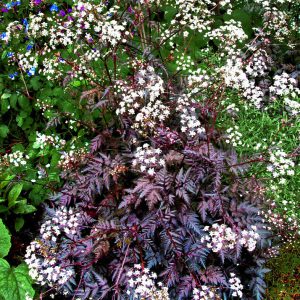- 1-9 pkts $4.50
- 10 pkts FREE
- Express post $12
Aquilegia alpina
BLUE COLUMBINE
Aquilegia alpina is is the true blue Columbine.
So beloved in Europe’s summer hay meadows.
Large navy-blue quilled blooms
It bears large, navy blue flowers on tall branching stems.
Great show late spring & early summer
So putting on a great show in late spring and early summer.
Long-lived perennial & also self-sows
Aquilegia alpina is a long-lived perennial, but it is also a prolific self-sower.
Producing a flock of babies around itself.
Carpet under trees & shrubs
It is not invasive, but can always be relied upon to give some extra plants each year to start new colonies, carpet under trees and shrubs, or share with gardening friends.
Beautiful blues
Self sown babies of Aquilegia alpina remain relatively true to colour, as the blue gene is strong. However if there are other colours in nearby Columbines, then you can also get some lovely colour variations.
Frost & heat hardy
Aquilegia alpina forms a hardy, evergreen perennial clump.
It is frost and heat hardy.
Can tolerate dry shade
And can also tolerate some dry once established.
Particularly when it is given some shade, which is it’s natural habitat.
There it can happily grow untended and makes a water wise cover under taller trees or shrubs.
Plant in shade or sun
Plant Aquilegia alpina in Shade to ½ Shade for preference.
It naturally dwells amongst trees and shrubs.
However it can tolerate Full Sun in cooler climates, if it is well mulched for the summer.
Lovely cut flowers for floristry or a vase
Aquilegias make beautiful cut flowers for both professional florists and home decorators.
They last well in a vase and give a charming “old-world” look to arrangements and bouquets, as well as beautiful, rich colour.
Cutting for maximum vase life
Flowers are best cut in the morning, before the sun or heat dries the plants too much.
Vase life can be further extended by searing the ends of the stems – this can be done with a brief flame (a match can be used) or by briefly dipping the ends into boiling water.
This stop the stems from blocking up with sap and allow them to take up water well.
Then condition the flowers by standing them in a deep bucket of cold water, before you use them in a bouquet or floral arrangement.
Thumbs its nose to rabbits & deer
Rabbits and deer shun Aquilegia alpina, as they pass by to tastier fodder.
Friendly to many pollinators, bees & birds
Aquilegia flowers are rich in both pollen and nectar – so they serve a wide range of pollinators.
Honey bees and native bees both love foraging amongst the flowers, and are particularly attracted to the blue and purple varieties.
While moths and butterflies are also frequent visitors, with white and pale Aquilegias favourites for night flying moths.
Our small, native honey eating birds are also delighted to sip nectar whilst perched on the branching stems.
Hardy evergreen perennial clump
Perennial clump approx. 80cm High in long spurred flower x 30cm Wide attractive foliage clump.
SEED SOWING ADVICE:
Sow seed of Aquilegia alpina at any time indoors in a punnet, whenever suitable temperatures are available (15- 20°C).
OR
Scatter the seeds directly in the garden in autumn and winter.
Aquilegias germinate easily in the garden after winter chilling.
Sow indoors for optimum germination: First sow the seeds in a punnet on the surface of good quality seed raising mix.
Then only barely cover the seeds with some sieved mix, because these seeds need light to germinate
Now thoroughly moisten the sown punnet by standing it in a shallow water bath and allowing the moisture to percolate up to the surface of the mix from below.
Then place the punnet in a warm, well-lit position (not in any direct sun).
Temperatures of 15- 20°C. are ideal for rapid and optimum germination.
And you can use a heat mat to maintain temperature, if you have one.
Though a warm window sill or corner will also do well.
Now continue to keep moist by misting the surface from a spray water bottle, to maintain consistent moisture.
Seeds germinate in 10-30 days.
However if there is no germination in 4 weeks, then it means the seeds have entered their natural dormancy.
So cling-wrap the moist, sown punnet and keep it in fridge (not freezer) for 4-6 weeks.
Then return to the well-lit position at 15-20°C.
Seedlings may begin to germinate in 10 days.
But do not discard the punnet as some seeds will continue to germinate for up to 30-90 days.
And this is perfectly natural for this plant.
Seed Count: 50 seeds per pack approx.
(We always aim to exceed the stated seed count and give a generous serve).
Click here for Nursery Open Days & Open Gardens Information
https://www.gardivalia.com.au/open-gardens
Click here to go back to Seeds Shop
https://www.seedscape.net.au/shop/
Related products
-
Add to WishlistAlready In WishlistAdd to Wishlist
-
Add to WishlistAlready In WishlistAdd to Wishlist
-
Add to WishlistAlready In WishlistAdd to Wishlist
-
Add to WishlistAlready In WishlistAdd to Wishlist





